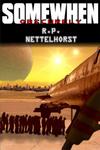The premise of the Sci-Fi Network TV show Stargate SG1 is that the US Government has a secret project based on alien technology. Unearthed in Egypt back in the 1920s, the Stargate is a device that creates a wormhole between Earth and thousands of other worlds across the galaxy. The Stargate allows teams of explorers to travel to those strange planets. Additionally, thanks to other captured alien technology, the government has built a small fleet of interstellar spaceships.
The fascination that people have for secret government military bases such as the one at Groom Lake, Nevada, often referred to as Area 51, is the delicious hope that things like what we see in science fiction shows such as Stargate are really squirreled away there.
The reality is doubtless much more pedestrian. Still, it was intriguing this week to read the article in Aviation Week and Space Technology (a magazine that some refer to as “Aviation Leak”) that something very interesting indeed is hidden there. According to the article in the current issue of AW&ST, “U.S. intelligence agencies may have quietly mothballed a highly classified two-stage-to-orbit spaceplane system designed in the 1980s for reconnaissance, satellite-insertion and, possibly, weapons delivery. It could be a victim of shrinking federal budgets strained by war costs, or it may not have met performance or operational goals. This two-vehicle "Blackstar" carrier/orbiter system may have been declared operational during the 1990s.”
The article went on to describe the vehicle in quite a bit of detail, indicating that they had a number of sources to back up what they were describing. Blackstar was a two-part vehicle, like the White Knight and SpaceShipOne combo that Burt Rutan designed to win the X-Prize in 2004. But the military version was considerably larger and could put the spaceplane into orbit. The carrier craft was similar to the XB-70, a supersonic bomber that the military developed back in the 1960s. According to AW&ST, the mother ship is a clipped wing delta aircraft about 200 feet long. The orbiter that it carried apparently comes in two versions: the small one is about 60-65 feet long and a larger version that was 97.5 feet long. Either apparently can haul two astronauts and cargo into low earth orbit.
The mother ship has the designation SR-3 and the orbiter is called an XOV (Experimental Orbital Vehicle). The engines on the XOV burn a new fuel that is a boron-based gel having the consistency of toothpaste and high-energy characteristics, but occupying less volume than other more ordinary sorts of fuels.
What was the Blackstar used for? AW&ST said that it was used for reconnaissance, taking the place of Lockheed’s SR71 which was phased out of service during the 1990s. Additionaly Blackstar could insert small satellites into orbit, service other spacecraft, and retrieve items from orbit. Conceivably, such a vehicle could serve as an anti-satellite or space-to-ground weapons-delivery platform, as well. One thing it might be used for is to drop what’s called “rods from God”: tungsten rods that are dropped from orbit and hit with rather extreme kinetic energy with no explosive warhead necessary. Because of their impact speed, they would be able to take out deeply buried bunkers.
Jerry Pournelle, now known primarily as a science fiction writer, first conceived of such a weapon back in the 1950’s; he called it Thor. In commenting about the Aviation Week and Space Technology article, he wrote on his website: “As some of you may know, I ‘invented’ Thor a long time ago. I have no idea who decided to call it ‘Rods from God,’ but while I was in operations research back in the 1950's I developed the notion of ‘orbital telephone poles’ made of tungsten, to be coupled with the Thoth Missile guidance systems we were developing at Boeing. Thoth was a ground control system to be used by a forward observer team.”
Going on about the article in AW&ST, he wrote: “And for years we all knew there was something like this, but it was REALLY classified.... Space ‘cruisers’ were part of the original High Frontier SDI [President Reagan’s so-called Star Wars] concept. General Graham's team included Max Hunter, me, and a number of others. High Frontier was mostly interested in strategic defense, so my development of Thor was never part of that.”
Given that there has been no official confirmation of the Blastar program, some questions have been raised by critics about the accuracy of Aviation Week and Space Technology’s report. However, the objections thus far can be summarized as, “well, in the 1950’s or 1960’s we thought about this or that aspect of Blackstar, but there were technical issues we couldn’t overcome.” Given that Blackstar would have only begun flying in the 1990’s, such technical issues of the 1950s and 60s would seem not particularly relevant.
The sad aspect to the article is that Aviation Week and Space Technology indicates that the Blackstar fleet has probably been mothballed, perhaps for budgetary reasons. One would wish that if this kind of technology has really been developed that it could be declassified and turned over to our civilian space program. I suspect NASA could figure out something to do with it.
Tuesday, March 07, 2006
Subscribe to:
Post Comments (Atom)






1 comment:
As I'm sure Burt Rutan and a host others also could. Too bad.
Post a Comment